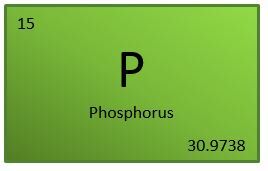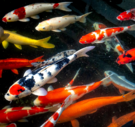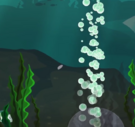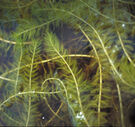
Phosphorous is one of three main nutrients in fertilizer. If you grow a garden and use fertilizer, you are using phosphorous, denoted as the P in NPK; Nitrogen, Phosphorous, and Potassium.
Phosphorus can be found in soil as well as suspended in water or attached to plants or animals. It is a key nutrient that can aid in the growth of crops and appears in many human driven agricultural, industrial, and urban activities (Bruulsema, et al., 2011).
While using phosphorous to grow beautiful flowers and bountiful crops in agriculture is all fine and good, when excess phosphorous gets into your pond, it accelerates aquatic plant growth and the occurence of algae blooms.
Algae blooms are a particular pond problem. When an algae bloom dies, it sinks to the bottom and rots. This produces an unpleasant odor (the 'rotten eggs' smell) and oxygen depletion, which can be extremely detrimental to fish.
According to A Phosphorus Primer, phosphorus pollution comes from point and non-point sources (Bruulsema, et al., 2011). A point source is when phosphorus enters the body of water from a specific location. A non-point source comes from diffused and variable points across a landscape, and is not as easily identified. The majority of phosphorus pollution in rural areas come from non-point sources such as cropland erosion and runoff. This can make managing phosphorous pollution challenging.
Normally aquatic plant and algae growth is slow due to low levels of naturally occuring phosphorus in water sources. When phosphorus or other nutrients are added to water, algae and plants are able to grow and the water becomes “Eutrophic”.
“Eutrophic is the term used to describe the condition of nutrient enrichment when aquatic plant growth becomes excessive. One of the key concerns of eutrophication is the impact of oxygen levels.” (Bruulsema, et al., 2011).
Algae grows quickly and dies quickly. When an algae bloom dies it sinks to the bottom to decay, and bacteria work extra hard to consume the organic matter, using up a lot of dissolved oxygen in the process. Low levels of oxygen have adverse affects on the aquatic organisms in the ecosystem. “trout, salmon, and aquatic insects such as mayfly, stonefly, and caddisfly are particularly sensitive to low levels of oxygen”. (Bruulsema, et al., 2011).
Management practices can help reduce phosphorus pollution. Each case of nutrient pollution is unique, as different point or non-point sources can be responsible. Therefore, practices are usually specific to the sources, and what works for one case may not be suitable for every farm operation. However, there are some guiding principles that can apply to many agricultural operations.
For non-point sources the best management practices are to educate yourself about what’s in your soil, water, and any fertilizers or products you are using. Nutrient management planning and materials testing can help you identify where your phosphorus loads are coming from and how much you are dealing with. You also want to keep phosphorus in the soil and keep your soil on your cropland. Soil management and soil erosion control can help in doing so (Bruulsema, et al., 2011).
Point sources are a little easier to manage if you can identify the sources and reduce the amount of phosphorus at the source, whether that be your milking center, livestock yard, greenhouse or other point source. Proper water management is an important best practice to divert clean water and treat contaminated liquids to reduce the risk of pollution. It is also important to manage concentrated sources and diluted sources differently (Bruulsema, et al., 2011).
Koenders Water Solutions is focused on reducing nutrient pollution in a sustainable and environmentally friendly way. Koenders has worked with close to 100,000 pond and lake owners to deploy a 3 step program of sustainable practices to tackle nutrient pollution, called Natures Pond Care.
Nature’s Pond three-step program is designed to fight phosphorus and nutrient pollution in ponds. With three simple steps you can Renew, Revive, and Remove to:
Natures Pond Conditioner is made from a natural blend of beneficial bacteria, enzymes, plant extracts and a food-grade dye. This powerful formula goes to work breaking down and consuming phosphorus and other nutrients.
Once the phosphorus and other polluting nutrients have been broken down, bottom up aeration infuses the water with oxygen, allowing the digested nutrients to make its way out of the pond and into the air.
Finally remove unwanted aquatic vegetation manually to maintain the health of your pond with the Cutter n’ Rake.
By following our simple, cost-effective 3-step program, you can eliminate the effects of phosphorus and improve the health of your pond, naturally. For more information about Nature’s Pond Care, Click Here.

For more information about Phosphorus Pollution, Follow the link below to order your free copy of “A Phosphorus Primer”.
Bruulsema, T., Davies, P., Dobbs, F., Stephens, S., Brown, C., …, J., O’Halloran, I. (2011). A Phosphorus Primer. Agriculture Canada, Agri-food Canada. Ontario Ministry of Agriculture, Food and Rural Affairs. Ontario Federation of Agriculture.
This blog discusses pond issues and solutions for Homeowner Associations.

This blog discusses the history of koi, tips and care suggestions, and how to keep a koi pond clean and clear.

Aeration Systems and the Benefits of Bottom UP Aeration…
A quick look at how Nature's Pond Conditioner works for your pond!

What is an Ecosystem? “An ecosystem is a geographic…